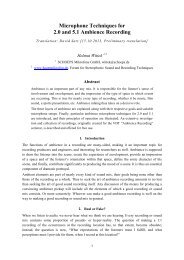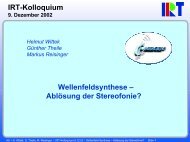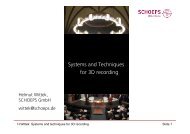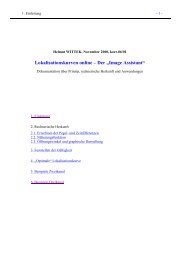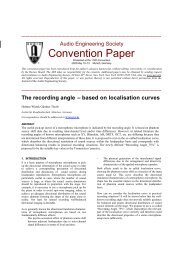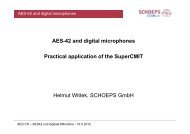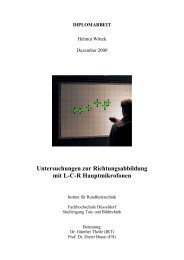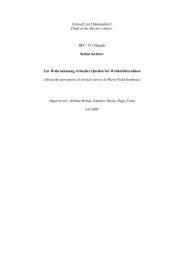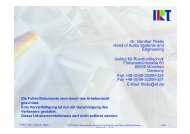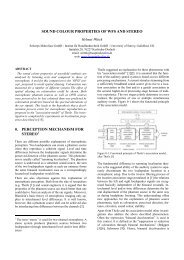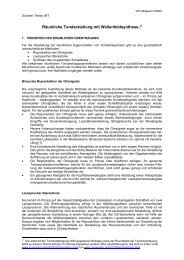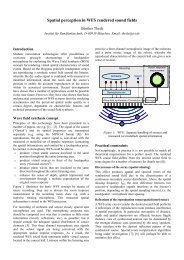on the localisation in the superimposed soundfield - Hauptmikrofon ...
on the localisation in the superimposed soundfield - Hauptmikrofon ...
on the localisation in the superimposed soundfield - Hauptmikrofon ...
You also want an ePaper? Increase the reach of your titles
YUMPU automatically turns print PDFs into web optimized ePapers that Google loves.
30<br />
In terms of <strong>the</strong> localisati<strong>on</strong> model to be depicted below, it is assumed that directi<strong>on</strong><br />
and distance are <strong>in</strong>separable qualities of spatial hear<strong>in</strong>g.<br />
It is strik<strong>in</strong>g that <strong>in</strong> <strong>the</strong> area of visual percepti<strong>on</strong> many genu<strong>in</strong>e percepti<strong>on</strong> models are<br />
known, whereas this is hardly <strong>the</strong> case for auditory percepti<strong>on</strong>. From a<br />
neurophysiologist and <strong>in</strong>formati<strong>on</strong> <strong>the</strong>orist’s viewpo<strong>in</strong>t this is <strong>in</strong>comprehensible, as no<br />
fundamental differences exist between <strong>the</strong> eye and ear’s functi<strong>on</strong> as receptors of<br />
<strong>in</strong>formati<strong>on</strong>. N<strong>on</strong>e<strong>the</strong>less, <strong>the</strong>re are two reas<strong>on</strong>s for this deficiency. Firstly, due to<br />
commercial reas<strong>on</strong>s a much larger <strong>in</strong>terest exists for technical applicati<strong>on</strong>s of visual<br />
percepti<strong>on</strong> models (data reducti<strong>on</strong> by means of appropriate source cod<strong>in</strong>g for image<br />
transmissi<strong>on</strong>, e.g. replicati<strong>on</strong> of pattern recogniti<strong>on</strong> pr<strong>in</strong>ciples with <strong>the</strong> help of<br />
classificati<strong>on</strong> processes or adaptive filters). Sec<strong>on</strong>dly, pattern recogniti<strong>on</strong> and<br />
associati<strong>on</strong> pr<strong>in</strong>ciples are more clearly recognisable <strong>in</strong> visual compared to auditory<br />
percepti<strong>on</strong>.<br />
At this po<strong>in</strong>t, two perceptual models – <strong>on</strong>e from <strong>the</strong> visual and <strong>on</strong>e from <strong>the</strong> acoustical<br />
doma<strong>in</strong> – shall be briefly del<strong>in</strong>eated, s<strong>in</strong>ce <strong>the</strong>y c<strong>on</strong>ta<strong>in</strong> mechanisms also featured <strong>in</strong><br />
<strong>the</strong> new localisati<strong>on</strong> model.<br />
Replicat<strong>in</strong>g <strong>the</strong> visual system, MARKO 1974, 1978 proposed <strong>the</strong> so-called “layer<br />
model” for pattern recogniti<strong>on</strong>, which he based <strong>on</strong> c<strong>on</strong>siderati<strong>on</strong>s of system <strong>the</strong>ory<br />
(see Figure 14).<br />
The “layer” is meant to symbolise a layer of neur<strong>on</strong>s <strong>on</strong> which <strong>on</strong>e should imag<strong>in</strong>e<br />
excitati<strong>on</strong> patterns. The hatch<strong>in</strong>g of <strong>the</strong> layer is supposed to <strong>in</strong>dicate that threshold<br />
elements are present at <strong>the</strong> output, so that <strong>on</strong>ly suprathreshold signals are passed <strong>on</strong>.<br />
In terms of system <strong>the</strong>ory, this arrangement corresp<strong>on</strong>ds to a multi-stage threshold<br />
logic. The n<strong>on</strong>-l<strong>in</strong>earity given by <strong>the</strong> threshold elements is crucial for <strong>the</strong><br />
classificati<strong>on</strong> process. With<strong>in</strong> <strong>the</strong> discrete stages, local filter<strong>in</strong>g is carried out<br />
(orientati<strong>on</strong>-selective filter, edge detecti<strong>on</strong>), <strong>the</strong> subsequent n<strong>on</strong>-l<strong>in</strong>ear distorti<strong>on</strong> (e.g.<br />
maximum detecti<strong>on</strong>) enabl<strong>in</strong>g <strong>the</strong> classificati<strong>on</strong>. It is worth emphasis<strong>in</strong>g <strong>the</strong> multistage<br />
pr<strong>in</strong>ciple of this classificati<strong>on</strong> model.<br />
The pattern characteristics are discrim<strong>in</strong>ated and forwarded <strong>on</strong>e after <strong>the</strong> o<strong>the</strong>r. They<br />
complement each o<strong>the</strong>r after hav<strong>in</strong>g passed through all layers, thus form<strong>in</strong>g <strong>the</strong><br />
complete pattern. This is also a feature of <strong>the</strong> associati<strong>on</strong> model.



